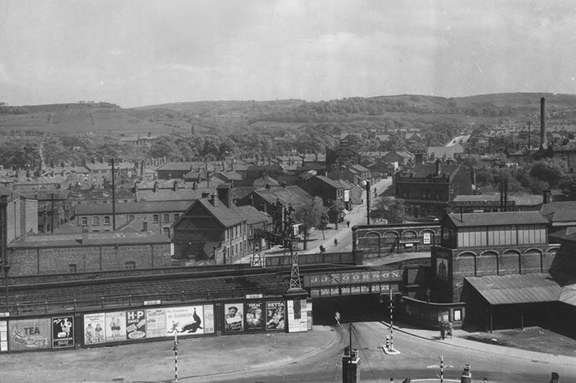- Home
- News
- What’s On
- Activities for Children
- Arts & Crafts
- Autos and Bikes
- Business events
- Car Boot & Auctions
- Charity events
- Churches & Religious
- Comedy
- Dance
- Days out & Local interest
- Education
- Exhibition
- Film
- Gardening & Horticulture
- Health
- Markets & Fairs
- Music
- Nature & Environment
- Spiritual
- Sport
- Talks and Discussions
- Theatre and Drama
- Business
- Local Information
- Jobs
- Deaths
- Charity events
- Contact Us
The Road to Wigan Pier and Macclesfield

Main image: Macclesfield station in Orwell’s day (Photo: Hulton Archive)
The Mirror carries details of their project with University of Portsmouth’s A Vision of Britain Through Time to compare data as part of the Wigan Pier Project, following in the footsteps of George Orwell’s famous journey through Britain
The Mirror writes: It’s always been seen as a relatively affluent area, but in 2017, the gulf between those who are thriving and surviving in Macclesfield is huge.
While many of the areas on Orwell’s route see large numbers of working or middle class households, the majority of residents here are either upper or lower class.
So while a wealthy third consider themselves to be upper class, another quarter says they are lower class.
Road to Wigan Pier 2017: Recreating George Orwell’s journey 80 years on and mapping modern Britain
Using 1931 census figures from the University of Portsmouth’s A Vision of Britain Through Time we’ve been able to see how much things have changed in the 80 years since Orwell’s visit.
Macclesfield – part of the Cheshire East area – has a particularly high proportion of upper class people compared to the rest of England and Wales.
Almost one in three (31 per cent) were classed as upper class, meaning they were professionals or managers, the last time figures were collected in 2011.
This has risen from 20 per cent of workers who were upper class in 1931, just before Orwell’s trip.
By comparison, almost a quarter (23 per cent) describe themselves as lower class, up from the 15 per cent seen by Orwell (according to 1931 figures).
Elsewhere, Macclesfield has a relatively low number of rough sleepers compared to the rest of the country.
According to official figures, there were at least four people sleeping rough in Cheshire East at the end of October 2016 – down from 12 people counted just two years before.
In comparison, the number of rough sleepers counted across England as a whole has risen by more than 50 per cent over the same period, and is now at a little over twice what it was in 2010.
And when it comes to key poverty indicators such as unemployment, infant mortality and overcrowded housing, things have only improved for Cheshire East since Orwell wrote his book.
Compared to other locations on George Orwell’s route for The Road to Wigan Pier, Cheshire East didn’t fare too badly when it came to key poverty figures in the 1930s.
In terms of infant mortality, a shocking 54 in every 1,000 babies born in Cheshire East in the 1930s died before the age of one.
By 2014, death rates for babies under the age of one had plummeted to just seven in every 1,000 babies.
This was pretty similar to the drop in infant deaths seen across England and Wales – the 1930s saw 66 infant deaths for every 1,000 babies, dropping to just six in every 1,000 by 2014.
Meanwhile, the rate of unemployment has also massively improved in the Cheshire East.
Around 10 per cent of all economically active men and women in the area were unemployed in 1931, which was slightly lower than the rate for England and Wales.
Across the two countries the unemployment rate was 11 per cent. Since then, official estimates show the rate of unemployment for all 16-64 year olds in England and Wales fell to five per cent in 2016.
Again, the rate in Cheshire is slightly lower at less than four per cent, putting the area in the top third of the country when it comes to employment.
Similarly, the problem of overcrowding is now almost non-existent in Cheshire East.
The 1930s saw 12 per cent of people in Cheshire East living in households with more than 1.5 people per room – the standard for measuring overcrowded housing in England and Wales.
That’s nowhere near as bad as the 19 per cent of people who were living in overcrowded households nationwide.
In comparison, just one per cent of people across England and Wales were living in households with more than 1.5 people per room in 2011 – the latest figures available.
Cheshire East, meanwhile, saw an even more marked improvement with just 0.2 per cent of people living in overcrowded housing in the area.
Full item: http://www.mirror.co.uk/news/politics/shock-figures-show-gulf-between-10504843



You must be logged in to post a comment Login